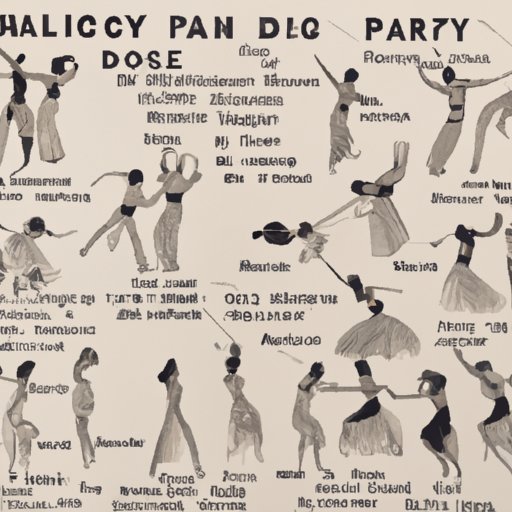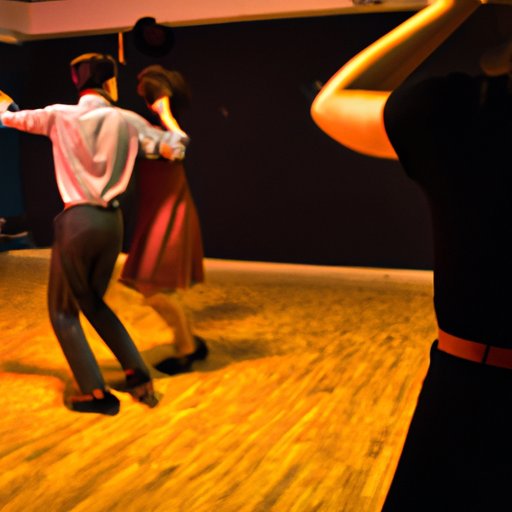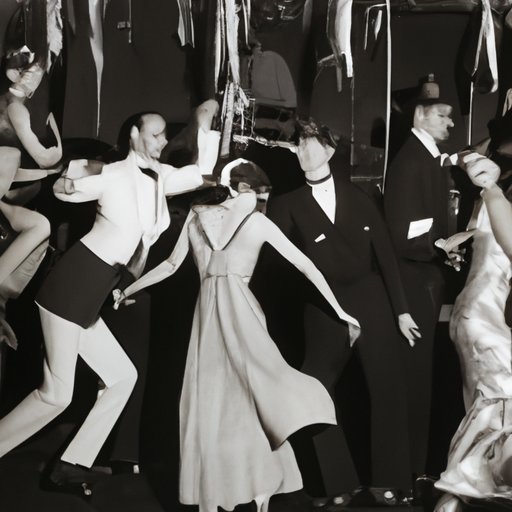Introduction
The 1920s are often referred to as the “Roaring Twenties” due to the economic and social changes that occurred during this decade. One of the most memorable aspects of the 1920s was the emergence of various dance crazes. These dances, such as the Charleston, Lindy Hop, Jitterbugging, Balboa, Foxtrot, and Breakaway, had a significant impact on music, fashion, and culture. This article will explore the popular dance crazes of the 1920s and how they evolved over time.

Historical Overview of Popular Dance Crazes from the 1920s
The 1920s saw the emergence of several popular dance styles, each with its own unique set of steps and moves. The most popular of these dance styles was the Charleston, which originated in the United States and quickly spread across the world. The Lindy Hop, another popular dance style, was developed by African Americans in Harlem, New York City. Other notable dance styles from the 1920s include Jitterbugging, Balboa, Foxtrot, and Breakaway.
Examining the Influence of the Charleston on Dance Culture
The Charleston is one of the most iconic dance styles of the 1920s. It originated in the United States, primarily among African Americans, and quickly spread around the world. The dance consists of fast-paced, energetic movements and is usually performed solo or in pairs. It was popularized by the Broadway musical “Runnin’ Wild” in 1923 and its popularity only grew from there.
The Charleston had a profound impact on music, fashion, and dance. Its upbeat tempo and lively movements inspired a new wave of jazz music and spawned a whole new genre of dance music. The Charleston also influenced fashion, particularly women’s clothing. The short skirts, knee-high socks, and bobbed hairstyles associated with the Charleston became popular among flappers, the young women of the 1920s who embraced a more liberated lifestyle.

Investigating the Birth of the Lindy Hop and Its Impact
The Lindy Hop is another iconic dance style of the 1920s. It originated in Harlem, New York City, among African American dancers and quickly spread throughout the United States and Europe. The Lindy Hop is characterized by its high energy, acrobatic moves, and intricate footwork. It is usually performed in pairs and can be danced to both fast and slow tempos.
The Lindy Hop had a significant impact on music, fashion, and dance. Its syncopated rhythms and complex steps inspired a new wave of jazz music, with many musicians incorporating the Lindy Hop into their songs. The Lindy Hop also influenced fashion, with the bright colors and flashy clothes associated with the dance becoming popular among flappers. The Lindy Hop also helped to popularize swing dancing, which is still popular today.
A Look at Other Notable Dance Styles from the 1920s
In addition to the Charleston and Lindy Hop, several other dance styles emerged during the 1920s. Jitterbugging, a fast-paced partner dance, was popularized by the film “Hellzapoppin” in 1941. Balboa, a swing dance characterized by close embrace and circular movements, was developed in Southern California. Foxtrot, an elegant ballroom dance, was popularized by the film “Shall We Dance” in 1937. And Breakaway, a solo dance characterized by its improvisational nature, was developed in the late 1920s.

How Dance Crazes Evolved Over Time During the Roaring Twenties
The popularity of dance crazes during the 1920s was due to a combination of music influences, social changes, and cultural elements. Jazz music, which originated in the United States in the early 1900s, was a major influence on dance culture during the 1920s. The rise of the flapper movement, with its emphasis on youth, freedom, and rebellion, also helped to popularize dance crazes. And the prohibition era, with its underground clubs and speakeasies, provided a perfect environment for people to express themselves through dance.
Exploring the Intersection of Music, Fashion, and Dance in the 1920s
The 1920s were a time of great social and cultural change, and music, fashion, and dance all played an important role in this transformation. Jazz music, with its syncopated rhythms and improvisational nature, provided the perfect backdrop for the energetic dance crazes of the 1920s. The flapper movement, with its bright colors and daring fashions, encouraged young people to express themselves through dance. And the prohibition era, with its clandestine clubs and speakeasies, provided a space for people to let loose and have fun.
Conclusion
The 1920s were a time of great social and cultural change. This decade saw the emergence of various dance crazes, including the Charleston, Lindy Hop, Jitterbugging, Balboa, Foxtrot, and Breakaway, each of which had a significant impact on music, fashion, and culture. These dance crazes not only helped to shape the music and fashion of the time, but they also provided a way for people to express themselves and have fun during a tumultuous period in history.
(Note: Is this article not meeting your expectations? Do you have knowledge or insights to share? Unlock new opportunities and expand your reach by joining our authors team. Click Registration to join us and share your expertise with our readers.)
